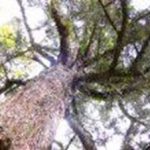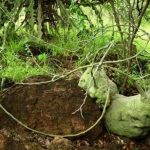TREE LIFE
MAY 2001
SUBS ($200) WERE DUE ON 1ST APRIL. PLEASE USE THE INVOICE ATTACHED TO THE APRIL TREE LIFE WHEN MAKING PAYMENT, INDICATING IF YOUR ADDRESS HAS CHANGED.
MASHONALAND CALENDAR
Saturday 5 May Botanic Garden Walk – meet in the car park of the Botanic Garden at 10.45 for 11 am. where we will meet Tom. and continue with the topics of great interest to us all – ‘Jesse and Kalahari sands ‘.
Sunday 20 May. The 51st A.G.M takes place at the lecture theatre next to the tea room in the Botanic Gardens, Fifth Street.
Tea will be served at 9.30 am followed by the meeting. Please bring your chair and a plate of eats to share and your picnic lunch. After the meeting we will have an informal walk in the gardens.
Saturday 26 May Mark’s Walk is at Domboshawa.
Saturday 2 June Botanic Garden Walk
MATABELELAND CALENDAR
Thursday 24 May A.G.M. at Girls’ College at 7.30 pm. After the meeting there will be a video on plants. Please attend.
Chairman’s Report 2000-2001 20th May 2001
Although the past year has not been the happiest for Zimbabwe, for the Tree Society it has not been all doom and gloom, and the Harare Branch was fortunate when the only outing cancelled was in June, to make way for the elections.
During the year we visited Chabweno in the Enterprise area, the Sieberts and Chenaux Reponds in the Sentosa suburb, Mick Fleet in Umwindsidale, Gosha Park near Marondera, the Bird Sanctuary near Lake Chevero, Sable Park in Trelawney, Seddies Farm in Glendale, Serui Source in Norton, and in March we visited Guitenwood in Mutepatepa. An impressive list made possible largely by the hospitality and kindness of our farmers, who in spite of enormous problems always made us so welcome. We thank our leaders on these outings who impart such a wealth of knowledge.
The Matabeleland Branch, was able to visit several places around Bulawayo, and from write-ups we learned something of the interesting aspects of Nyamandhlovu, Hillside Dams, Khami, the NUST Campus, Leopard Rock Nature Reserve, and Kloof Farm.
As usual the walks in the Botanic Gardens have been interesting and instructive. The subjects Tom covered this year included – the seldom seen trees on our field cards – the families Rutaceae , Myrtaceae, and the genera Brachystegia, Diospyros, and Terminalia. The interesting subject of ‘Jesse bush’ and Kalahari Sands continues. We always look forward to these walks with Tom and are very grateful that he can find the time for us. Our thanks, also, to Mark for recording the botanical facts for us in Tree Life.
Mark’s group too was active with two visits to Mr Hatendi ‘s property, – walks in Christon Bank and at Cleveland Dam, – a lovely afternoon spent at Val D’Or in Goromonzi, – a fascinating walk around the Prince Edward School Arboretum where Leslee Maarsdorp was largely responsible for planting trees many years ago, and to the Mukuvisi Woodlands where Julia’s list gave out after more than 60 species had been described by Mark. We also had a chance to see something of the plants in the grounds of the University where it was decided a return trip is needed. Thank you Mark.
Three very successful long trips were undertaken this year. The Bulawayo Branch organised the wonderful visit to Gem Farm and Sentinel Ranch in the lowveld.
The Bubi River in April was an eye opener after the floods and Outward Bound in the Chimanimani mountains was the venue for the Easter and Independant holidays – this write up is eagerly awaited.
Some special occasions were celebrated this year – Barbara Tunney’s 90th birthday, followed by John Cottrill ‘s 80th birthday, two great achievements and we salute you.
Our Tree Society turned 50 and an effort is being made to capture some of its history.
We had some sad occasions too when long standing members Doug Siebert, Lyn Davey Isobel Defterios and recently Georgie Granelli died. To their relatives and friends we say ‘we share your sorrow’.
In December we sadly bade farewell to the Haxen family. Phil and Cheryl contributed a great deal to the Society over many years and we shall miss them. We wish them well in their new life ‘down under’.
A new project this year has been the production of a list of Ndebele plant names, which will be followed soon by a list of Shona names. This mammoth task has been undertaken by Lyn Mullin.
To negate some of the postal costs we are experimenting with sending Tree Life by e-mail to some guinea pig members, and still on the hi-tech scene, a web site on the internet for the Tree Society will soon be a fact. Our Mapping project continues, but the South African Protea Atlassing venture which we were just getting into has sadly come to an end. We found its approach in recording data to be interesting and challenging. From the feed back we believe this was a very successful and worthwhile project.
Because of the continuing fuel shortages many members were unable to attend the outings but could visualise proceedings from the vivid and informative write-ups in Tree Life, and we thank Mark Hyde, J P Felu, Jonathan Timberlake, Norma Hughes, John Lawrence, and Doug Ball for ‘putting us in the picture’.
Interesting and thought provoking articles have come from Lyn Mullin, John Wilson, Peter Taylor and Ian Riddell. These contributions are enjoyed by us all and we thank you for taking the trouble. We thank Vida Siebert who continues with the boring, tedious, tiresome but vital task of collating and posting Tree Life every month.
All this, of course, takes organisation and planning and we record our thanks to the hard working committees of both the Harare and Bulawayo branches.
-Andy MacNaughtan.
SERUI SOURCE FARM, NORTON: 18 FEBRUARY 2001
The persistent, extraordinary, wet weather and the fuel problems took their toll and there were only 9 people on the outing, which included our hosts. But although the little rivers were up, there was no particular difficulty in getting into the farm, where we had a warm welcome from Jim and Ann Sinclair
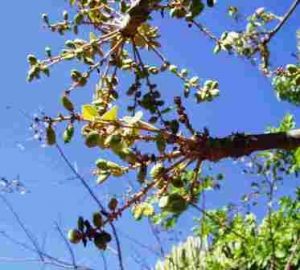
Lannea discolor. Photo: Mark Hyde. Source: Flora of Zimbabwe
Those that missed it missed a gem of an outing with beautiful trees and much of interest.
After tea on the veranda, we set off though what one might call sandveld miombo woodland. The altitude of the farm is 1400 m, i.e. a reasonably high altitude with most of the trees typical of those we see around Harare. Given all the rain, the herbaceous flora was magnificent and in addition to the woodland, we passed along the edges of extensive grassy vleis with their own distinctive flora.
One interesting point was checked out. In Van Wyk & Van Wyk’s Field Guide to the Trees of Southern Africa, p. 444, Lannea discolor (the Live-long) is said to have latex. This common tree belongs to the family Anacardiaceae, in which as far as I was aware, the only Zimbabwean representative with latex was the genus Ozoroa. Breaking off a whole leaf of the Lannea appeared to produce no milk but breaking off a leaflet led to a small amount of milk oozing from the cut petiolule. This was definitely a new fact to me.
According to Van Wyk & Van Wyk, not only L. discolor but also L. schweinfurthii (False marula), Harpephyllum caffrum (a commonly planted street tree in Harare), Schinus terebinthifolius (also planted) and Sclerocarya birrea (the true marula), all of which belong to the Anacardiaceae all also produce latex. This is certainly useful information but somewhat mitigated by the reluctant. It’s a bit like the Sapotaceae, for example Mimusops zeyheri and Manilkara mochisia, which are also milky, but are rather reluctant to produce it on all occasions.
[Just checked a Schinus molle from the garden – this does have milk; but I can’t get anything from a Harpephyllum caffrum in Harry Pichanick Drive. This seems to be a subject for further research].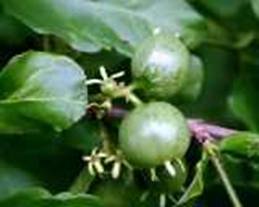
Vangueria randii. Photo: Bart Wursten. Source: Flora of Zimbabwe
Another small tree of interest was Vangueria randii (the Ant-heap wild medlar). This seems to be a very widespread species, but is scattered and never seems to be particularly abundant, so we don’t see it that often. The leaves are typical Rubiaceae – opposite, with interpetiolar stipules but are a shiny green which separates it from the common V. infausta. Maureen pointed out the prominent whitish veins beneath.
A small area of disturbance by the roadside produced Tribulus terrestris (variously known as calthrop, devil’s thorn or deviltje). It is a prostrate species with greyish, pinnate leaves, attractive yellow flowers and ferociously spiny fruits. In Zimbabwe it appears to be mainly a species of lower altitudes, and is therefore a bit unexpected there, but it also behaves as a weed and appears on roadsides in Kadoma and even in Harare, where it appears to be spreading. It’s an interesting case of an introduction within an area from a different altitude.
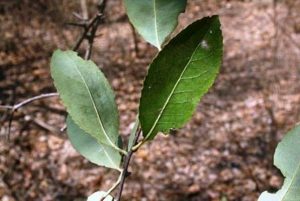
Elaeodendron matabelicum . Photo: Mark Hyde. Source: Flora of Zimbabwe
A specimen of Elaeodendron matabelicum (Cassine matabelica) caught our attention.
This has usually opposite, thickly-textured leaves and although widespread tends to be a bit sporadic in occurrence. This particular one was covered in numerous froghoppers. Further on, Ann showed us an Afzelia quanzensis (Pod Mahogany). This is a rather high altitude for this species but it doesn’t appear to have been planted.
A grove of Euclea natalensis was spotted. These were 4-5 metres high – somewhat tall for this species. Specimens of Acacia amythethophylla were also present. This has some of the largest leaves of any of our acacias and is also a late-flowering species.
In the sandy woodland was an umbellifer, Diplolophium zambesianum. Southern Africa is generally rather poor in umbellifers – it certainly doesn’t have any equivalent of English country lanes full of Cow Parsley. But this is probably our commonest species – occurring in open woodland. It is closely related to the Blister bush (Diplolophium buchananii subsp. swynnertonii) which is well known from the Chimanimani mountains. Whether D.zambesianum has similar blistering properties is not known and no-one tried it out.
After a while, we reached a large Securidaca longipedunculata (Violet tree), which we had seen in full flower when the Protea Atlas people visited. Nearby was a clump of bush containing the white flowers of Grewia stolzii (the Green-petalled cross-berry). Also present was Elaeodendron transvaalense (Three-petalled cassine). This is a very misleading species; its leaves vary from deeply spine-toothed to almost entire. However, even in the latter case, very fine teeth are present which can be of assistance. It has also changed its genus rather a lot – from Crocoxylon in Flora Zambesiaca to Cassine in Coates-Palgrave and now to Elaeodendron.
A frequent component of the woodland by this time was the jacaranda. It was extremely well naturalised, much to the disgust of some of our members.
Three species of Protea were seen: P. angolensis var. divaricata, P. gaguedi and P. welwitschii. The identification problem with these appears to be that intermediates between gaguedi and welwitschii occur. These are not entirely hairless as in gaguedi but have some brownish hairs like welwitschii, but these are much sparser than normal welwitschii.
In a vlei, it was nice to see a herbaceous species of Hypericum, namely H. lalandii. This appears to be a fairly widespread species. Also seen were the prostrate stems of the legume Rhynchosia monophylla. The name suggests that it has simple leaves but in practice it has a mixture of both simple and 3-foliolate. Perhaps the most striking feature is its bicoloured flowers which are red and yellow.
At this stage, we found ourselves in a thicker, more evergreen type of woodland. Here was Bobgunnia madagascariensis (the new name for Swartzia, the Snake bean), and rather surprisingly Euphorbia matabelensis (Three-forked ). This seemed to be rather out of habitat; we usually see it in thin soil over rocks and rocky crevices. Also found was a non-climbing Ceropegia, with its extraordinary flowers with connate tips.
Apart from a very brief shower, the weather had remained dry throughout our walk, but on returning to the homestead for a late lunch, the heavens opened and we were able to eat our lunch under the veranda and marvel at the good timing.
All in all, a large number of species were seen. Our thanks go to the Sinclair’s for hosting us in such a beautiful place.
Finally, a plea for more people to volunteer to write up our outings. One of the great strengths of the Society is its regular monthly outing and the record which appears soon after in Tree Life. Many people feel that they are not expert enough – but do not worry about that. Any committee member would be willing to give assistance where necessary. Alternatively, greater emphasis could be given to the people and the social side of the outings.
-MAHyde
NUST Sunday 11th March 2001
The campus of the National University of Science and Technology has a diverse, multi-faceted flora. The dominant trees are probably Albizia sp. I saw A. amara and A. harveyii.
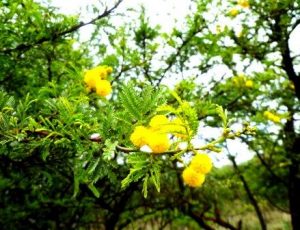
Acacia karoo. Photo: Paul Hubbard. Source: Flora of Zimbabwe
There were six Acacias:- A. arenaria, A. galpinii, A. gerrardii, A. karroo, A. nilotica and A. rehmanniana. Due no doubt to the peculiar pattern of rainfall, with some long, dry spells followed by an extended period of rainy weather, this summer, the Acacia karroo has been absolutely spectacularly beautiful in flower. I don’t think I have ever seen it so lovely for so long. A. rehmaniana has put forth its white pom-pom blossoms several times too. The excellent rainy season last year probably contributed to these displays.
The Combretums were represented by four varieties: C. apiculatum, C. hereroensis, C. imberbe and C. molle, as were the Commiphoras:- C. africana, C. glandulosa, C. mollis and C. schimperi.
Over fifty different trees were observed here. Whilst the other members of the outing penetrated the extensive woodland thicket, I wandered around the roads. There was a wash away fissure on one corner where I was able to make a small collection of most attractive stones. I was unable to tell whether these were part of the original parent geology, or whether they emanated from elsewhere, and had been transported there to construct the road. Most of them were green, but a few were black and yellow.
There was as wealth of bird life. I saw Swallows, Swifts and Rock Martins, hawking low over the grassy spaces. Two Paradise Whydahs (males) were performing their courtship flights, rising higher and higher, trailing their “widows’ weeds”, before suddenly descending to perch on a convenient tree. I never observed their wives, which was unusual.
There was a flock of Quelias. One by one, they dropped down to the ground, like the dried leaves falling off a tree, until suddenly the whole flock rose in a cloud, as is their wont, when something startled them. I wondered what they were consuming. The grasses were certainly laden with seed, but it all seemed too green and unripe to be eaten.
I heard several birds that I never saw. The call of the Red-naped Lark can be interpreted either as “piri piri”, or “hullo Billy”. The Three-striped Tchagra Shrike’s up and down, roundabout song rang through the woodland. Then there was the chuckle of the Laughing Dove. The rusty, creaking sound of a Francolin, possibly Swainson’s which I know inhabits this area, grated across the scene.
I saw two raptors:- A Black-shouldered Kite hovered and then swooped, but I couldn’t see whether it killed or not, as it was too far into a thicket. An eagle flew by lazily. It was being harassed by a small flock of Pied Crows, but easily evaded their attacks, either by lifting itself above them, or drifting below their clumsy sorties. Once, I saw a talon being extended menacingly towards a rash corvine raider that ventured too close. This bird nearly fell out of the sky in its frantic effort to avoid being caught off guard. I was prevented by the angle of the light from seeing the eagle closely enough to identify it positively.
On one side of a road, what appeared to be leaves of a watermelon attracted my attention. Closer inspection revealed very many tiny yellow and green striped hirsute melons. They were certainly very decorative. They were identified by Anthon as Cucumis myriacarpus. The specific name means “ten thousand fruits” and it was certainly well-named. Anthon said that this is one of the most poisonous of the Cucurbits. “However,” he added, “it is unlikely that anyone would die after eating them, because the fruits are extremely bitter.” I was curious as to how he had acquired such insight. In fact, he had tasted them!
Joy Kets told of a swarm of bees hanging on the underside of a big tree branch. Perhaps they had been evicted? As it is not really the swarming season, it seems possible that flooding rain had driven them out of a hole in the ground.
Beside one road was a trench which obviously held water. The shrill trill of a frog syncopated the bird calls fitfully.
This was an interesting and unusual outing.
-NORMA HUGHES.
Botanic Garden Walk 2nd April 2001 JESSE – PART 1
At this month’s Botanic Garden walk on 3 April, 2001, Tom discussed and showed to us the species of the Jesse and those of Kalahari sand and because these are separate subjects and will be continuing next month, the write-up has been separated into two. Each part has been called Part 1, so that it can be extended next month.
Firstly, what is jesse? In Tom’s view, undisturbed jesse consists of dry forest with very tall (to 30 m) trees of such species as Xylia, Pteleopsis and Combretum. In practice, because of man’s direct influence or indirect (by allowing elephant populations to build up) such jesse is now rarely seen. Today, jesse mainly consists of a scrub-like thicket without, or with very few, big trees and composed mainly of shrubs and woody climbers, which are sometimes almost impenetrable, so dense are the interlocking stems.
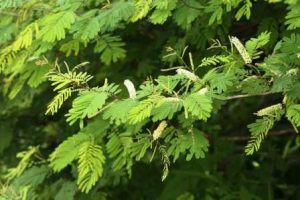
Acacia ataxacantha . Photo: Bart Wursten. Source: Flora of Zimbabwe
The term itself seems to be a local term with its use confined to the Zambezi Valley, but the origin is obscure. Tom did not know it. For the purposes of this article, I asked Jonathan Timberlake who informs me that some believe that it may be derived from a the vernacular name for Acacia ataxacantha (a common component). It is certainly likely that it is of vernacular origin.
As far as I know, jesse only occurs in the Zambezi valley, although Tom remarked that similar vegetation types occur in the Limpopo Valley as well. Jesse only occurs at low altitudes (below, say, 1000 m?) and only in low rainfall areas.
Tom explained that there are difficulties in describing which species are to be found in jesse, namely:
- the species composition varies from place to place – for example the jesse around Gokwe differs from that at (say) Mana Pools;
- some (very few) species are highly characteristic of the jesse to the extent that they occur almost nowhere else (Tom’s example of this was Meiostemon tetrandrus), whereas
- other species, while typical of and common in the jesse occur significantly in other associations (E.g. Entandophragma caudatum);
- while still others which generally occur in other associations are occasionally to be found in the jesse (e.g. mopane).
One of the most significant families in the jesse is the Combretaceae, and in the heart of the jesse is Meiostemon tetrandrus. This was originally named as a Combretum and it differs from that genus in having 4 stamens whereas combretums have 8-10. Tom showed us two other features of this species, namely its branches which look like pinnate leaves and the 4-winged fruit which grows on a long peduncle. This species is one of the few which is almost confined to the jesse, but both Meg and Tom have seen it in other habitats.
Another major component of most jesse is Pteleopsis myrtifolia, although Tom pointed out that it occurs in rain-forest in the Rusitu valley and also on rocky outcrops. This species can attain 30 m as a canopy tree.
The other species of Pteleopsis in Zimbabwe is Pteleopsis anisoptera. Tom mentioned that this species is a component of jesse in the Gokwe area but not in the Zambezi Valley. It also occurs in rocky outcrops.
The third important genus in this family is Combretum and the three most important jesse species are Combretum celastroides, C. collinum and C. elaeagnoides.
- celastroides is usually a shrub and often partly climbing. The scales are large and under a lens the leaf appears to have translucent glands – an unusual feature in this genus. C. collinum, the aptly-named Variable combretum, often occurs in the jesse in a form with greyish leaves. C. elaeagnoides looks like an Elaeagnus in the sense that it is covered in prominent, brownish silvery scales.
Another important family is the Leguminosae. The subfamily Mimosoideae has two important species. Firstly, Xylia torreana, which is a very common canopy tree, sometimes attaining 30 m. The leaves have only 1 pair of pinnae and the flowers occur in yellowish, spherical heads.
The other species of note is Acacia ataxacantha, which with its numerous prickles, adds a “wait-a-bit” component to the jesse.
In the Papilionoideae, we have Pterocarpus lucens. This is a common, canopy tree with a distinctive battleship-grey bark and fluted trunk, of which both features were well demonstrated in the Gardens. It has compound leaves with alternate leaflets and small yellow flowers.
Another important species in the jesse is Entandophragma caudatum, the Wooden banana, which belongs to the Meliaceae. This has, unusually, paripinnate leaves with relatively long petiolules and the I’m sure generally familiar peeling-banana-shaped fruit and winged seeds. It is not confined to the jesse and occurs at lower altitudes on rocky kopjes.
Another important family is the Burseraceae and the genus Commiphora. Specific species mentioned by Tom were C. karibensis and C. ugogensis. The former is somewhat similar to mollis but differs in having shiny, glabrous leaves. The trunk is typically gun-metal grey and strongly fluted, a feature sometimes also present in mollis. Like many other species, it is not confined to jesse but occurs elsewhere, for example on rocky kopjes. This species has a watery, not milky, latex.
- ugogensis has serrate leaflets and a trunk which is brown, peeling to green and not fluted at all. It occurs in “nodules” in jesse and also on other formations. It has milky latex.
Having covered, the main species, I will finish off Part 1 by dealing with the other jesse species noted by Tom. As before, these will be dealt with by family. I hope that more will be added next month.
In the Rhamnaceae, Berchemia discolor may occur in the jesse and Tom mentioned some huge ones at Mana Pools. Another species is Excoecaria bussei, the Pawnbroker tree, in the Euphorbiaceae, which has milky juice and serrate leaves.
Finally, Kirkia acuminata (Simaroubaceae) may occur at the edge of the jesse and occasionally Colophospermum mopane (Leguminosae – Caesalpinioideae) may also occur, but it is hardly typical of it.
As usual, our thanks go to Tom for a very stimulating walk on this very interesting subject.
-MAHyde
THE MANKETTI TREE
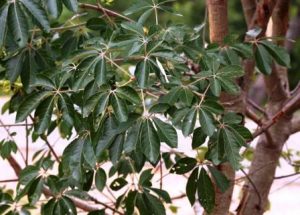
Schinziophyton rautanenii. Photo: Bart Wursten. Source: Flora of Zimbabwe
I have always wondered why the name Manketti was given to a tree I have known forever by its Ndebele names as umgongo or umgoma (Schinziophyton rautanenii, formerly Ricinodendron rautanenii). The answer was inadvertently supplied by Peter Godwin, of “MUKIWA” fame, in an article on the Bushmen published in the February 2001 edition of the National Geographic. On page 102 he wrote of joining a group of women who were on a foraging expedition “to gather mangetti nuts…which are a rich source of protein”. A comparison of the Namibia location map in the article with the distribution map of the species in Coates Palgrave tied the two together, and there we have it. Manketti or mangetti appear to be Bushman (San) names.
Lyn Mullin
3-FOLIATE OR 3-FOLIOLATE?
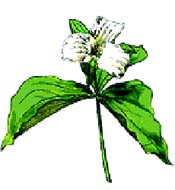
3-FOLIATE OR 3-FOLIOLATE?
In Tree Life no. 253 there was a discussion about what the terms “3-foliate” and “3-foliolate” mean and whether there is a difference.
I would have thought there were two possible meanings:
| 1 | An object (usually a plant or stem) with 3 leaves; and |
| 2 | An object (usually a leaf) with 3 leaflets. |
A quick glance at various glossaries in my library shows that there is no consistency in usage. The term “3-foliate” appears to be used indiscriminately for both meanings. On the other hand, 3-foliolate appears only to be used for meaning 2.
Ideally and for consistency, I would recommend that 3-foliate should be used to mean 3 leaves and 3-foliolate to mean 3 leaflets.
In our flora, we have numerous species with 3 leaflets – e.g. many legumes, Anacardiaceae (Rhus), Burseraceae (Commiphora), Dioscoreaceae (Dioscorea), Rutaceae (some!), Sapindaceae (Allophylus) and many others.
However, cases of plants with 3 leaves are very unusual and I can’t think of any from Zimbabwe. However, the genus Trillium from the USA would probably qualify. See the picture below.
-MAHyde
ANDY MACNAUGHTAN CHAIRMAN


